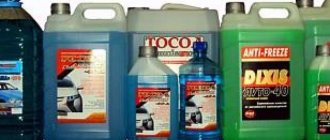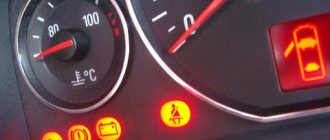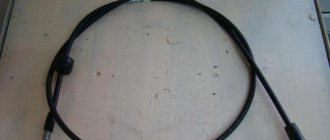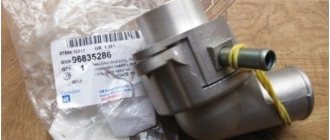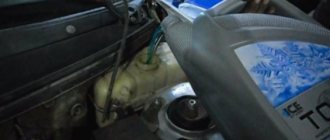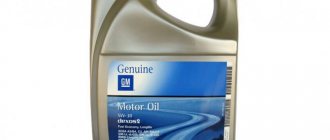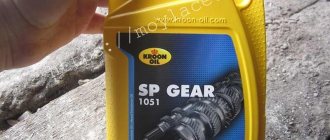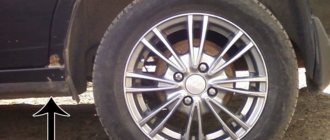According to the manufacturer's maintenance regulations, the coolant in Chevrolet Lacetti cars should be changed every 45 thousand kilometers or after three years of operation, whichever comes first. It is possible for the manufacturer to use coolant with a service life of 240 thousand km or 5 years.
Video
The video will tell you how to properly change your car's coolant.
What coolant is for the Lacetti?
The Chevrolet Lacetti cooling system uses high-profile ethylene glycol-based coolant (antifreeze).
The most important component in antifreeze is silicates, which protect aluminum from corrosion.
As a rule, antifreeze is sold in the form of a concentrate, which must be diluted with distilled water in a 50:50 ratio before filling. And when using a car at temperatures below minus 40 ° C - in a ratio of 60:40. It is necessary to dilute the antifreeze with distilled water first (before pouring it into the cooling system).
The most popular today are antifreezes of the G11 standard and the G12/G13 group of standards. In fact, the designation G11, G12, G12+, G12++ and G13 are market names for VW antifreeze standards TL 774-C, TL 774-F, TL 774-G and TL 774-J. Each of these standards imposes strict requirements on the composition of the product, as well as on the range of its properties.
G11 (VW TL 774-C) is a blue-green coolant (color may vary depending on manufacturer). The service life of this antifreeze is no more than 3 years.
Antifreeze G12 red is a development of the G11 standard. It allowed, first of all, to increase the recommended service life to 5 years. Antifreezes G12+ and G12++ differ quite significantly from regular G12 in their formulation and properties. Antifreezes of these standards have a red-purple-pink color, also have an extended service life, however, unlike G12, they are much less aggressive, more environmentally friendly and can be mixed with blue G11. Mixing G11 and G12 is strictly not recommended. A further development was the G13 standard antifreeze. They are also purple-pink in color and are fully compatible with previous standards.
Personally, I use G12++ antifreeze from well-known brands.
Antifreeze Chevrolet Lacetti
For reliable and long-term operation of the power plant, it is necessary to maintain its temperature within a narrow range. A cooling system is used to absorb and dissipate heat. Its working fluid is antifreeze. The life of the power unit depends on its timely replacement and compliance with recommendations for selection.
General Motors branded coolant
Choosing antifreeze for the Chevrolet Lacetti
The original coolant produced by General Motors is Genuine Longlife Dex Cool. Branded coolant is quite difficult to find on sale, so car owners often resort to purchasing its direct analogue AC DELCO DE X-COOL Extended Life Antifreeze/Coolant.
Genuine General Motors antifreeze
In cars produced before 2011, it is recommended to use G12+ coolant. The service life of the fluid is 5 years, but car owners recommend changing it after 3 years.
In Chevrolet Lacetti cars after 2011 release, you need to use G12++ antifreeze. The service life of this antifreeze has been increased to 7 years.
Coolants G12+ and G12++ have similar performance characteristics and composition, therefore they are completely interchangeable. However, topping up is not recommended. If you intend to replace different types of antifreeze, then it is necessary to drain the entire volume of coolant and flush the circuit from the remnants of the old liquid.
Good third-party manufacturers of coolant for the Chevrolet Lacetti are the following companies:
- Chevron
- AWM
- G-Energy,
- Lukoil
- Ultra,
- GlasElf,
- havoline,
- MOTUL,
- Freecor,
- Frostschutzmittel,
- VAG,
- FEBI,
- Zerex G,
- Freecor QR,
- Freecor DSC,
- Glysantin G 40.
When choosing antifreeze, it is necessary to take into account the fact that it is not only responsible for the function of heat removal. The components contained in the coolant provide lubrication of the pump, increasing its service life. In addition, the antifreeze must contain additives:
- reducing scale formation,
- corrosion inhibitors,
- allowing you to maintain your original performance characteristics of the coolant for the entire service life.
Replacement frequency
The service life of antifreeze until it needs to be replaced, according to the manual, is from 5 to 7 years, depending on the type of coolant. Most often, car owners encounter unscheduled replacements due to the addition of low-quality corrosion inhibitors to the coolant. As a result, the antifreeze takes on a rusty color a couple of days after being poured into the circuit. It is strictly forbidden to delay replacing such a coolant, as irreversible damage to the walls of the radiator and cylinder block occurs. Also, unscheduled fluid replacement may be required for the following reasons:
- Liquid leaves the system as it flows through all seals and seals. This is due to the wrong choice of coolant. Its viscosity is lower than required.
- Excessive gas formation occurs in the circuit, despite the fact that the temperature of the power plant is within normal limits.
- Antifreeze gives off an unpleasant odor. In some cases, it even penetrates into the interior.
- Engine oil or other technical fluid has entered the coolant.
- Mixing of two types of antifreeze occurred, for example, as a result of emergency topping up.
- There was a persistent smell of burnt rubber.
Required tools and materials
In order to change the coolant on a Chevrolet Lacetti, you will need the tools listed in the table below.
| Tools and materials | Note |
| Screwdriver | Flat blade |
| Coolant drain container | Volume up to 9 liters |
| Distilled water | Required for diluting concentrated antifreeze. |
| When changing the type of antifreeze, you must first flush the circuit with distilled water. This will require a liquid volume of 7 to 13 liters. | |
| Pliers | Can be replaced with pliers |
| Rubber tube | Diameter 10 mm |
Description of antifreeze replacement for Chevrolet Lacetti
In order to replace the coolant in a Chevrolet Lacetti, you should use the instructions below.
- Secure the vehicle with the parking brake. Work should be performed with the engine cooled down and turned off.
- Open the car hood.
- Unscrew the cap of the expansion tank.
Expansion tank Chevrolet Lacetti
- Place a container under the radiator to drain the liquid.
- Unscrew the drain valve on the radiator.
Drain tap location
- Unscrew the drain plug.
Drain plug location
- While the coolant is flowing out, visually assess its condition. It should not contain foreign objects, such as pieces of rust. There should be no burnt odor or significant color change.
- To flush the system, pour distilled water into the expansion tank.
The process of pouring distilled water into the expansion tank
- Start the engine.
- Warm up the engine to operating temperature.
- Shut down the power plant.
- Wait until the engine cools down.
- Drain distilled water.
Expansion tank after flushing
- Fill with fresh coolant. The antifreeze level should correspond to the MAX mark. Close the lid.
Liquid level control
- Start the engine.
- Visually inspect the cooling system circuit for leaks.
Similar:
- Chevrolet Captiva engines Crossovers are highly valued in our country, so the Chevrolet Captiva has appealed to car enthusiasts. This is an excellent option both for the city and for long trips. By.
- Chevrolet B12D1 engineChevrolet B12D1 engine This engine is found not only on Chevrolet models, but also on various European, Chinese and Japanese cars. This demand for the engine is due.
- Choosing tires and wheels for a Chevrolet lacetti The competent choice of tires for a car is the calculation of all parameters, technical characteristics and standard sizes for a specific brand, taking into account operating conditions, seasonality and road conditions.
- Chevrolet Lacetti won't start Many owners of the Chevrolet Lacetti have encountered the fact that their favorite “iron horse” at one certain moment does not start. So, a car enthusiast gets into the car and turns.
Leave a comment Cancel reply
You must be logged in to post a comment.
When to change coolant
It all depends not on the brand and recommendations of the car manufacturer, but on the antifreeze used and the condition (age) of the car.
If you use G11 antifreeze, then replacement should be carried out every 2 years, or 30-40 thousand km. mileage
If G12, G12+, G12++ were filled in, then you need to remember about replacement after 5 years, or 200 thousand km. mileage
Personally, I use G12++ and change it every 4 years, or 100 thousand km. mileage
But, to be honest, 100 thousand km. I've never rolled. Four years passed faster than I achieved this mileage.
There may also be moments in life that make adjustments to the timing of replacement and the antifreeze used. As an example, I will give two from my life.
First, there was a war here and even grocery stores stopped working. Therefore, one could generally forget about auto parts stores. The mail didn't work either. Therefore, I had to buy a canister of “green Felix” from local dealers. At the first opportunity in the future, I tried to change it to the usual red G12++. But this “green stuff” served its two years quite well.
Secondly, the plug in the cooling jacket in the cylinder head leaked. Naturally, the oil mixed with antifreeze and it had to be replaced much ahead of schedule.
And most importantly, do not exceed replacement intervals. Old coolant actively corrodes the cylinder head, pump, fittings, and other elements of the cooling system.
What kind of oil to pour into a Chevrolet Lacetti engine
I tried a lot of things - Castrols and M obils , etc... But one day one good person recommended me the German ARAL oil. He filled it into his Mitsubishi Outlander immediately after replacing the factory one. This oil could only be purchased from a dealer in metal cans. At first I was quite skeptical about this proposal, but when he opened the filler neck and showed me the engine, I was certainly amazed! The mileage is 130 thousand km, and everything shines like new! And then my heart melted - I decided to try it, since my Lacetti has less mileage, and the engine, as it turned out, is “not like new” :)
What is needed to replace the coolant
To replace the coolant we will need:
— Screwdriver
— Antifreeze concentrate, or ready-made antifreeze
— Distilled water (about 15 liters)
— A container for draining used coolant. It is highly advisable to use a container with displacement divisions. For this I use a 10 liter canister of primer
— Rubber or silicone hose 10 mm in diameter.
— For ease of work, an inspection hole or overpass is required. But it's not at all necessary.
If you change antifreeze without an inspection ditch or overpass, then you need a low container and a 12mm wrench.
Replacement process
Using regular tap water is strictly prohibited. The same applies to antifreeze that has a composition not regulated by the manufacturer.
List of what is needed for work:
A quick guide to replacing the coolant on a Chevrolet Lacetti system:
- Place the car on a flat surface. Place a container underneath for drainage.
- When the engine is cold, the coolant level in the tank should be between o and “MAX”. It should be remembered that the antifreeze level increases or decreases depending on the temperature increase/cooling of the engine.
- Using a slotted screwdriver, unscrew the drain valve on the car radiator a couple of turns and drain the antifreeze.
- Before unscrewing the drain valve, we put a rubber hose with a diameter of 10 mm on the radiator drain fitting and place it in a container for draining the coolant. In this way, you can avoid loss of antifreeze when draining and flooding parts of the cooling system.
- We tighten the valve to drain the coolant.
- Slowly, pour new antifreeze into the SOD expansion tank in a thin stream.
- Coolant is a toxic technical fluid. Avoid contact of coolant with skin.
- Screw on the expansion tank cap and start the engine.
- We check for antifreeze leaks.
- We turn off the engine and after it has cooled, we check the coolant level and, if necessary, add antifreeze to the system to the required level.
- Please note that all the liquid will not flow out of the system, about two liters remain there, so very often car owners rinse with distilled water (3 times) and use antifreeze concentrate as coolant (taking into account that some of the distilled water is already in the system).
To drain more fluid, it is recommended to either jack up the rear of the car or combine replacing the coolant with replacing the pump.
Coolant replacement
Note! Replace the vehicle's coolant at an engine temperature of no more than + 40 °C to avoid burns.
Open the expansion tank cap to relieve pressure in the system and close it again!
We take a container for draining waste fluid, a rubber tube, a screwdriver and head under the car.
Unscrew the five engine protection bolts and remove the protection.
From the lower end of the radiator, a little to the right of the center (if you look in the direction of travel), we find the drain fitting and put a tube on it. You don’t have to put it on, but this way less liquid will spill. We direct the second end of the tube into a container to drain the liquid.
It is more convenient to use transparent silicone hose
Using a slotted screwdriver, unscrew the drain plug of the radiator of the cooling system several turns. Just not by much, otherwise it might fly out under the pressure of the liquid!
Now open the filler cap of the tank again. After this, the waste liquid should begin to flow more quickly from the drain fitting. It will take a long time to leak, so you can vacuum the interior and wash the floor mats for now.
We wait until the liquid begins to flow less intensely.
We tighten the cap of the expansion tank and disconnect the hose from the tank that goes to the throttle assembly. Close the fitting on the tank with your finger and blow into the hose with your mouth
This way the liquid will come out faster and in a larger volume (i.e. less will remain in the system)
When only air comes out, then we can say that we have drained the used antifreeze.
We screw the radiator drain fitting back into place and connect the hose back to the expansion tank, which we removed.
If the coolant level on your car was at a minimum, then about 6 liters should drain
If the tank was at the MAX mark, then naturally more fluid would drain out.
The main thing is that the same amount is poured into the system as was drained. If it fits less, then there is a plug somewhere or other problems in the form of blockages.
Fill the tank with distilled water
Start and warm up the engine to operating temperature.
For 1 minute, keep the engine speed at about 3000 rpm.
Turn the interior heater control to the red zone (maximum heating). Turn on the heater fan and check that hot air is flowing. This means that fluid circulates normally through the heater radiator.

